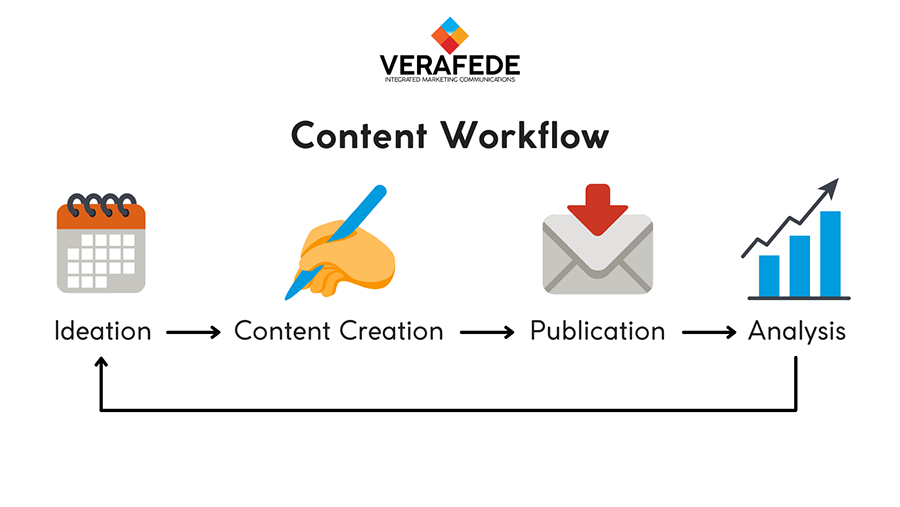Share
Ever heard of the marketing rule of seven?
According to this rule, it takes consumers an average of seven interactions with a brand before they make purchase decisions. Similarly, it applies to content marketing, whereas audiences have to consume an immense amount of content before they proceed to the purchasing stage.
If we’re talking about shortening the time it takes for customers to buy, then a brand should produce a lot of content. But it’s not as easy as it sounds. You make a series of high-quality articles one after the other. And the key to do this is to have a well-planned and detailed content workflow.
If you want to scale up your content creation while maintaining its quality, read on to find out more about the step-by-step guide that guarantees positive results!
What is a Content Workflow?

Different content strategists have their own unique takes on the processes and guidelines of content workflow. They adapt and adjust to what’s best for the brand or business. But the common process is as follows: ideation, content creation, editing, approval, publication, and analysis.
The cycle loops back when creating new content. Some marketers include intricate steps necessary for more efficient and effective workflow.
But there is no one-size-fits-all content workflow; it is important to build one depending on what the business needs.
Needless to say, each content strategist will have to work their way to achieving their different goals. Let’s use the example above to discuss the step-by-step guide for creating the main moving parts of a content workflow.
Ideation

Everything has to start with planning.
Ensure first that you know what your content is about. When working with a team, set up goals depending on what you want your content to achieve, whether it is for engagement or awareness.
After this, proceed with listing topics. Create topic clusters and ideate themes first that can be broken down into bite-sized content.
Some content strategists will have a topic bank where members can contribute topics to be covered in their content. The goal is to have as much material in case a topic does not fit the content goal.
Before you start executing anything, figure out what the format and design should look like.
- Will your content be in the form of blog posts or social media posts?
- What should the logo and branding be?
Specify these details before getting started. Give your content workflow a branding guideline—remember, the devil is in the details.
Even better, create some content templates that your team can just follow and tweak depending on the type of content. This method will speed up your content production while ensuring consistency in format and design.
Set realistic goals and describe what you want your content to do. This will help you with the next steps of your workflow.
Content Creation, Editing, and Approval

After careful and strategic planning, you are now in the phase of content creation. The heart of your workflow.
This phase is divided into three parts: creation, editing, and approval.
Presuming you have created a content guideline that your team can follow, start making a content calendar to set the deadlines. Each part of this phase will need some time to get done. You will have to guesstimate how much time it takes to finish each task before its publication.
When working with teams, give them access to the calendar. You can also use various work management software to help manage the project and make sure everyone is on the same page with the content timeline.
Editing
Once the content and layout have been created, it is time to make necessary changes based on the business’s branding guidelines, vision, and mission.
It is either the lead, copywriter, or the content creators’ responsibilities to review and edit grammatical structures, tones, designs, and anything that needs improvement.
You can use copywriting and proofreading tools to make things easier. To reduce the time spent back and forth between the editor and creator, you can also utilize some software that provides real-time collaboration and commenting.
Approval
Approval is not as easy as it sounds.
Some content strategists set minimum criteria or checklists that the content should meet.
You don’t have to do it all alone, though. You can assign team members to review the contents. They can give your content creator feedback or ideas that can be used right away or for the next piece.
Publishing

The hardest part of your content workflow is over; you can just sit back and watch your content gain traction. But not so fast!
Don’t just hit publish and move on to your next piece. That one piece of content you just made will not promote itself to the audience. You have to be strategic about how you are going to promote and distribute that content!
Go back to your content goal and assess what kind of distribution and promotion it needs. For example, if your content falls under awareness, you might want to reach as many channels as you can.
It is a great idea to tailor-fit a media strategy for your content. Normally, brands want an organic reach, but you can opt to spend on paid social media posts to increase views.
Remember that marketing your content should include the dynamics of the digital marketing trifecta (owned, paid, and earned media). Don’t be afraid of taking up new space as long as it benefits your content.
Now, it doesn’t end there. Keep track of your promotion strategies for the next and final step.
Analysis

The last part of your workflow is analyzing whether your content is successful or not.
Keeping track of your content until you make another one will give you some idea of what you should retain or improve, if there is any.
You need to know how your content impacts the entire marketing initiative. Ask yourself the necessary questions.
- Does this content reach the content goal I set?
- Does it help improve the things I want to improve?
- What are the strengths and weaknesses of this content?
- Are these factors necessary for my next content?
It is critical to get into the habit of checking the performance of your content.There are various Key Performance Indicators (KPIs) to measure the success of your content. From engagement rate to number of sign-ups and many more, this should reflect the goals you set from the very start of your workflow.
Your KPIs will determine your safe zone. But regular analysis of single pieces of content should be conducted along with an analysis of the entire performance of all of your content. In that way, you can see where you fall short and determine particular content types that work better with your audience.
The Secret to a Great Content Workflow
This commonly-used content workflow should give you an idea of what you’re working with and allow you to freely change it based on your brand’s needs.
Always keep in mind that there’s more to content workflow than these four steps. Others even include processes like prioritization, governance, optimization, and more.
It goes without saying that you can work how you want to work as long as it is effective, efficient, and it will not cost you and your team in the long run.
While you can make the process extra detailed and intricate, you have to first go through a degree of trial and error to figure out what perfectly fits for your team.
The secret to a great content workflow lies in finding a balance between a strategic workflow and space for your team to be creative and collaborative.
You can always make some changes based on experience or on updated marketing statistics. Always tweak your strategy and see how these adjustments can affect your content performance until you finally have the “perfect and unique” workflow.
So, are you ready to improve your content workflow?
If you need a marketing team to help you get it right, especially in conceptualizing and implementing great ideas, consider reaching out to a tried-and-tested marketing company.
Verafede is one of the most well-sought integrated marketing communications agencies in the Philippines!
We have been in business for more than eight years, and we have successfully helped small and big companies with their marketing campaigns!
If you want the same in your business, contact us, and let’s turn ideas into a great experience!
Related Reads:
“Are Bazaars Still A Thing?” How To Create A Direct To Consumer Brand Experience For Your Business
Heads Up, Start-Ups! Marketing Tips for Start-Up Businesses in 2021

Cezar V. Nacion
Cezar V. Nacion is a graduating student of Bachelor of Science in Business Administration Major in Marketing Management at De La Salle University - Dasmariñas. He is an intern at Verafede Inc. under the marketing department and social media team. His works interest marketing research enthusiasts through the discovery of different insights into marketing queries. He loves exploring the many facets of marketing as he finds each and every one unique.


